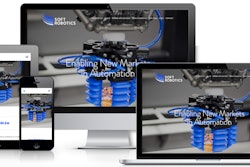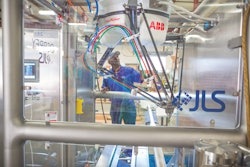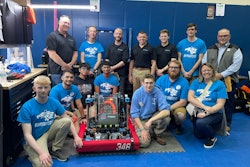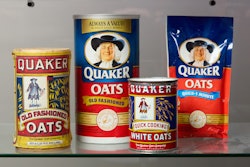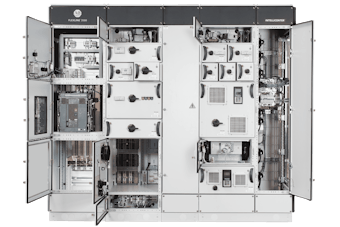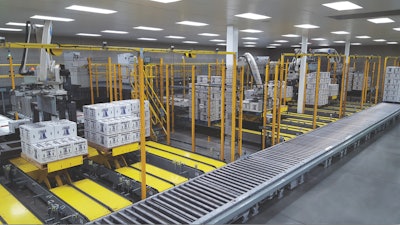
A market study from Technavio, “Global Packaging Robots Market 2016-2020,” paints a positive picture for the future of robots in the packaging plant, in particular food and beverage and pharmaceutical applications, with an estimated global CAGR of more than 9 percent during the forecast period.
According to the study, in 2015 the global market for packaging robots in the food and beverage industry was valued at $2.9 billion and is expected to reach $4.59 billion by 2020, growing at a CAGR of almost 10 percent.
“The food and beverage industry is rapidly deploying four-axis SCARA and six-axis articulated robots and delta-style robots for accelerating primary packaging process. These robots are low-cost, have quicker ROI over fixed automation, and offer a higher degree of flexibility,” reads the report.
The deployment of robots in the pharmaceutical industry has also grown over the last decade, the study says, reaching $790 million in 2015. By 2020, the global market for packaging robots for pharmaceuticals is expected to reach $1.27 billion, representing a CAGR of almost 10 percent.
“Flexibility and accuracy of robots allow the production line to run smoothly while consequently packaging products at a higher speed than fixed automation systems,” says the study. “Also, these machines reduce the risk of contamination from the direct contact of a human being in sterile environments during the packaging process.”
Inelligrated automates palletizing for cheese manufacturer
Sargento Foods, Inc. has been running a centralized palletizing system at its plant in Plymouth, Wisc., for almost two years. Installed in phases with completion in 2014, the system was implemented to replace manual palletizing on multiple production lines producing sliced, snack, and shredded natural cheese products.
Due to space limitations within the facility, the centralized palletizing concept was the most practical option. Requirements for the system included a neutral to positive return on cost of goods sold, a reduction in the forklift traffic around the production lines, improvements in the quality of work, especially ergonomics, and the installation of a robust and reliable system.
After competitive analysis, Sargento selected Intelligrated Systems (See them at PACK EXPO Las Vegas, booth #C-3906) to design and implement the system. According to Barry Blatz, Sargento’s senior project engineer for the project, Intelligrated offered the best combination of self-manufactured conveyor components, Fanuc robotics, large-system experience, and in-house controls integration.

During operation of the system, after cases are filled with product on each production line, they are sealed and labeled with a 128-style UPC code. They are then carried away from the production line by elevated conveyors to an overhead level and introduced to high-speed trunk-line conveyors. These conveyors further combine cases into a single file as they travel—up to 700 ft., in some cases—to the central palletizing area.
Once there, the UPC code on the case is read as the case enters the central palletizing area. Based on the product and the line on which it was produced, each case is conveyed to one of eight palletizing cells and diverted into one of three palletizing lanes. A Fanuc (See them at PACK EXPO Las Vegas, booth #C-4800) M-410iB robot within each cell uses a vacuum plenum end-of-arm tool to palletize according to a pattern developed by using Intelligrated programming within the Fanuc software. Each robotic cell has the capability to manage up to three production lines, depending on the type of case, pallet pattern, and cases per minute. Just for fun, the robots were aptly decorated with Swiss-hole decals to “cheesify” them.
After each pallet is finished, it is transferred from the cell via a transfer car and sent to automated warehousing. While on its way, the pallet is stretch-wrapped by a Wulftec (See them at PACK EXPO Las Vegas, booth #C-3445) WCRT-200 automatic rotary-arm stretch wrapper and is given a pallet license plate containing all necessary product information.
The Intelligrated-developed control system is based largely on Allen-Bradley components, including 87 ArmorStart® controllers, five ControlLogix® Safety PLCs, 20 MicroLogix™ ML 1100 PLCs, and 45 Variable Frequency Drives. Additionally, the system is network-based with three separate networks connecting all of the above with more than 800 photoeyes or proximity switches, 189 motor-driven rollers, 10 operator touchscreens, five device-level rings, and high-speed UPC scanners using 357 IP addresses.
According to Sargento system operators, the biggest issues with running this large palletizing system are related to the simplest components: wood pallets and corrugated cases. Pallets are inspected prior to being introduced into the system. Even so, occasionally a loose or missing board will cause a jam or stoppage within the system. Case gluing/taping is highly reliable, but on rare occasions, a flap may be left open. In both of these issues, the system will shut down and alert an operator of a fault. The operator can then initiate proper safety lockouts, enter the robotic cell, and correct the issue. In case of an extended issue, cases can be diverted to an area for hand-palletizing. To assist operators and keep track of the cases in transport and in the palletizing areas, eight cameras provide feedback at an operator area.
Columbia/Okura adds versatility to apple packing plant operations
Washington Fruit & Produce Company of Yakima, Wash., is a family-owned company that has been packing apples and cherries since 1916. The company operates two facilities, River Road South and River Road North, in operation since 2010 and 2015, respectively. According to Washington Fruit System Operator Mikey Hanks, Washington Fruit’s newest plant is “the fastest apple packing facility on earth,” processing an average of 4,000 apples per min.
In engineering the North facility’s case-palletizing operations, Washington Fruit duplicated a robotic system in use at its South facility supplied by Columbia/Okura LLC (See them at PACK EXPO Las Vegas, booth #C-2836). At its previous packing plant—in operation from 1993 to 2010—case palletizing was a manual job requiring as many as 12 workers.
“We didn’t consider automation at the time,” Hanks says. “That’s just how the facility was set up, and it worked. This was back before robotics were really taking off, so it really wasn’t a big deal.”
But with the South facility, Washington Fruit wanted palletizing equipment that could reduce labor as well as the ergonomic complaints resulting from manual stacking. Going into the process, Hanks admits the company didn’t know where to begin.

“We didn’t even know what requirements we were supposed to have,” he says.
Washington Fruit presented the OEM with information such as how many items they packed at a time, the number of lanes they wanted, the number of SKUs they wanted stacked at the same time, and the estimated packing speed. With this data, Columbia/Okura specified five robotic palletizing cells each equipped with an A1600 four-axis, multi-articulated robot arm and four lanes.
The system handles a range of apple varieties, pallet sizes, and pallet patterns simultaneously. The process begins when the facility’s packing line takes apples from a bin that’s been randomly picked from an orchard and runs them through electronic sizing and sorting equipment. For example, in the case of Gala apples, the fruit is first sized and sorted into 17 different sizes, after which they are separated into one of three different grades within those sizes. The apples are then packed into one of 13 different case sizes.
During packing, a license plate serial barcode is stamped onto each case that includes information on the size, grade, and color of the apple, the time of packing, and the orchard the fruit came from. As the cases approach the robotic palletizer in random order, a scanner reads the license plate and directs the case to the proper lane within the proper palletizing cell.
The license plate also directs the palletizing robot as to the correct pallet pattern for each lane. Sixteen different pallet patterns per lane are used at the North facility, while the South plant uses 28 per lane. Each lane also has the option of using one of four different pallet sizes, fed from four separate pallet dispensers.
“There are a lot of different variables going into this process, all of which are run from one barcode on the case,” Hanks says.
The robot picks up from one to three 49-lb. cases at a time using a clamp-style end-of-arm tool with fingers that grasp the bottom of the box. The gripper was custom-designed by Columbia/Okura to accommodate the company’s use of a two-part telescoping box. As Hanks explains, since apples can drift up and down throughout the day, a box can become a little taller or a little fuller.
“Because there’s a slight variance from box to box, when you pick up three boxes, if one of the cases is even one-sixteenth of an inch smaller than the others, the bottom of the case can slide out,” Hanks says. “So, the robot has a special ‘hand,’ we call it, that compensates for this.”
When the North system was initially set up, Hanks says Columbia/Okura programmed approximately eight of the pallet patterns, and he set up the rest himself, adding that the software is “a lot more user friendly than it used to be.”
Delkor Systems takes robotic case packing path to quick changeovers
When John B. Sanfilippo & Son, Inc. (JBSS)/Fisher Nuts decided to move toward greater automation of case packing for its pouched nut products, it not only realized a savings in labor, but it also saved significantly on its material costs. The company was originally looking just for automated solutions to replace the manual case forming, packing, and sealing of both shelf-ready packaging (SRP) and standard RSCs at two of its plants. What it got were automated systems from Delkor Systems Inc. (See them at PACK EXPO Las Vegas, booth #C-4340) that provided the desired flexibility, along with a new SRP format with greater shelf appeal and less packaging material.
“Fisher Nuts was initially against changing the appearance of their packaging [a two-piece SRP], until they saw the Delkor Cabrio Case, which alleviated their concerns with its clean, pre-cut front and wrapped corners,” says Rick Gessler, director of marketing & strategic account management for Delkor.
The patented and patents-pending Cabrio Case® is a single-piece tray-hood SRP that has a lift-off hood and machine-cut front and side edges that ensure a clean edge when the hood is removed. According to Delkor, the case saves from 10 percent to 20 percent in corrugated materials compared to a typical tear-away case, and 10 percent to 50 percent compared to a two-piece tray-and-hood combo. Primary packages are loaded and shipped flat in the case to reduce shifting and settling of the products inside, but are displayed vertically. Primary packages can also be shipped vertically, if required, using another variant of the Cabrio Case. Fisher Nuts is using bleached linerboard for the case to achieve high-impact, wraparound graphics.
According to Mike Cannon, senior vice president of corporate operations for JBSS, the most appealing aspects of the Cabrio were customer acceptance of the format and cost reduction.
In the area of equipment, Delkor recommended a fully automatic robotic case packer, the MSP Series, for JBSS’ Elgin, Ill., facility. For its Elgin and Selma, Texas, plants, Delkor specified four semi-automated hand-pack systems, each equipped with one Trayfecta S Series dual-head case former and two Capstone F Series case closers, both from Delkor.
At the Elgin plant, the fully automated line begins with a KHS Innopouch K-400 horizontal pouch machine that fills bag sizes from 2 to 24 oz. at speeds to 125/min. From there, pouches are conveyed lying flat, single file, to the MSP Series case packer. Upon entering the cell, a Fanuc M-2iA delta-style robot uses a vision system to detect pouch orientation. It then realigns skewed and random-pitched pouches (up to approximately ±20 deg) and places them in groups of two or three—depending on final pack configuration—onto a continuous-motion conveyor. From there, the pouches are conveyed to a Fanuc M-710iC Series six-axis robot that picks up from four to six pouches at a time, and packs them into the Cabrio Case. When required, the robot can also rotate layers or individual pouches to interleave them in standard RSCs or FSCs (flange-seal wraparound cases).
End-of-arm tooling for the Fanuc M-2iA comprises a lightweight vacuum head that picks a full pattern by collecting pouches one at a time. Tool changeover for this robot is a simple, tool-less operation.
For the M-710iC Series robot, an EOAT with multiple servo axes handles pouch interleaving and rotation, when required. An array of vacuum cups on each EOAT secures a firm grip on pouches prior to placement. To change over to a new tool, the operator selects the desired product and predefined pack pattern recipe from a touchscreen. The robot then parks the current EOAT on a rack within the case packer, and then picks up and attaches the new one. Other changes within the cell occur automatically as well, including the case conveyor flight pitch, adhesive patterns and vision recipes, and all of the servo-motion profiles.
One reason Cannon cites for only automating one case-packing line is the high changeover rate required for products on the hand-pack lines. For these lines, at each plant, a Trayfecta S Series dual-head former capable of running two different case sizes simultaneously is mated with two Capstone F Series closers. According to Gessler, the case former’s ability to run two case sizes at once helped keep the investment cost low versus having to install two separate erectors/formers to produce two cases at the same time.
The former is used to produce both Cabrio Cases as well as FSCs, which are manually packed by operators before being sealed by the Capstone F.
“The hand-pack lines can be upgraded in the future to automatic case packing, utilizing the existing former and closer,” Gessler says. “The low price of the hand-pack system allows for easy entry into shelf-ready packaging.”
Since being installed in September 2015, Gessler estimates that the automated systems, together with the new Cabrio Case SRP, have resulted in a labor savings of six to eight people, along with $750,000 per year in corrugated board material savings.
Cornerstone Automation Systems ramps up fully automated prescription assembly line
Celesio UK, a leading provider of integrated healthcare services to the National Health Service in the U.K., is pioneering a new model of prescription fulfillment services—“hub-and-spoke” dispensing—with the help of one of the world’s first fully automated prescription assembly lines.
In 2011, Celesio began working with Cornerstone Automation Systems, LLC (CASI) to develop an automated prescription assembly line in its Warrington, England, facility. The line’s primary function would be to assemble and label weekly blister trays, known as Community Dosage System (CDS) blister cards, for individual patients and ship them daily to LloydsPharmacy stores.
The CDS blister card, which has been widely adopted in the U.K. as a way to ensure patient adherence to medications, consists of a tray with 28 blisters, each capable of holding multiple tablets or capsules. The tray is divided into the seven days of the week, with four dosing occasions per day—morning, noon, teatime, and evening. A front cover attached to the spine of the tray is printed with patient information, pictures of the tablets or capsules, dosing information, and drug facts.
“You might have 17 different medications, each one with a different dosing pattern throughout the week,” says Mark Gillett, director, Pharmacy Channel for CASI. “So you’ve got to get it exactly right, with every medication placed in the right blister for the right times and the right days. That’s where it gets complicated.”
 With the hub-and-spoke concept, a single facility, such as Warrington, will act as the hub, supplying a number of pharmacies, or spokes, with assembled blister trays containing repeat patient prescriptions.
With the hub-and-spoke concept, a single facility, such as Warrington, will act as the hub, supplying a number of pharmacies, or spokes, with assembled blister trays containing repeat patient prescriptions.
“We currently produce the [multi-dose blister] cards in the pharmacy, which is hugely time-consuming and very reliant on manual operations, such as staff de-blistering pills, manually adding pills to the blister, printing off backing cards, etc.,” says Danny McNally, head of prescription assembly services for Celesio UK.
By automating blister-tray assembly at the hub, pharmacists at the spokes will be freed from the tedious task and will have more time to interact with patients as well as provide value-added services, such as treating minor ailments and injuries and administering vaccinations.
In its pilot phase, the new automated line is made up of multiple modular components from CASI that assemble the blister and frame, fill the trays with the pills, apply a backing card to the tray, and add the cover, at speeds to 15 trays per min.
At the first station, the frame of the blister tray—a paperboard card die-cut to accommodate the blisters and printed with the days of the week—is placed face down in a carrier containing 28 blister-shaped slots. Next, the blister piece is placed on top of the card, with the blisters fitting into the slots of the carrier, and the open sides of the blister facing up. These components are picked and placed into the carrier by a Fanuc LR Mate 200iD equipped with end-of-arm suction cups.
From there, the carrier with blister tray is conveyed to the filling portion of the line, which consists of eight filling modules, each stocked with hundreds of different medications held in specially engineered canisters. Depending on which medications must be dispensed into the tray, the carrier may stop at multiple stations.
When the blister tray reaches the correct filling station, it stops under a grid with 28 holes. To start the filling process, a Fanuc LR Mate 200iD six-axis robot uses a fork mechanism to pick up a canister holding the required pills and place it on a platform. Canisters are stored on a vertically rotating carousel with 10 shelves that can hold up to a maximum of 300 canisters (420 in an extended carousel), or 300 different medications, depending on the mix of canister sizes. When a filling module is in use, there will be one canister on each of two platforms—one that is actively being picked from and one that is on standby.
To prevent operator access to the pills, which can be controlled or non-controlled medications, the canister is designed with a special locking mechanism that can only be unlocked when placed on the platform. When the medication is ready to be picked, the lid of the canister is lifted using a proprietary technology from CASI. Once the lid is open, a Fanuc M-1iA/0.5S four-axis delta robot picks a single pill from the canister and places it through the 28-hole grid and into the proper blister in the tray, then repeats this picking process, as necessary, to place all pills into the proper blisters in the tray.
Several inspection technologies at the point of filling ensure the robot is correctly picking whole, unbroken pills and is dispensing them into the blister tray. First, a backlight is applied to the canister to produce a silhouette of the pills inside. “The robot’s vision system has been trained to look for a certain form and dimension of the pill,” Gillett says. “If it sees one that fits that form and dimension to within a programmable tolerance threshold, the robot will pick it up and place it into the blister card. This is important because you don’t want to be dispensing partial pills and counting them as whole, or even partial pills that you don’t count at all.”
When the robot drops a pill through the grid into a blister, the pill crosses a laser that is shot across the opening of the grid. The sensors detect that the pill has positively broken the plane of the laser and has gone into the card.
“If we detect that something has broken that light at a time when we’re not dropping a pill, it also flags that blister to be checked by the on-site pharmacist, in case a foreign substance has dropped into the blister,” Gillett says.
A third way the system checks that a pill has been correctly picked and placed is by monitoring the vacuum pressure in the picking tool, which changes when a pill is picked up and again when it is released.
“A lot of effort has been put into making sure we can get an accurate fill every time—no extra pills, no missing pills, no pills in the wrong blister, because this is a safety issue,” Gillett says.
CASI also incorporated proprietary technologies related to the picking tools for the Fanuc M-1iA/0.5S that eliminate cross contamination of pills versus conventional filling systems that may use the same tube or funnel to dispense multiple medications. CASI has also eliminated airborne cross contamination through the use of HEPA filtration.
Once a canister is emptied of all viable pills, the LR Mate 200iD robot in that module places the canister on a conveyor that carries it to the end of the line where it is placed in a queue before being picked up by a mobile robot and brought to the replenishment room. Referred to by CASI as the Automated Canister Replenishment Vehicle (ACRV), the Lynx mobile robot from Adept incorporates a locking system that prevents the unauthorized removal of drugs from the canisters inside. The ACRV also delivers filled canisters to the line, where they are automatically conveyed to the appropriate filling module and placed in the carousel by the LR Mate.
Meanwhile, on the prescription assembly line, after a blister tray has passed through the entire filling line and all of the medications associated with that tray have been dispensed, the tray is conveyed to an inspection system. If the tray is correct, it continues to a station where a backing card is heat-sealed to the tray.
In the next step, a cover and spine are attached to the tray. The cover protects the blisters and, at the next station, is printed with information on the drugs inside by a Videojet (See them at PACK EXPO Las Vegas, booth #C-1851) DataFlex 6420 thermal transfer overprinter.
“It prints the information on-demand for that specific customer and includes two color pictures of each drug showing two different angles, dosing information, drug facts, and more,” Gillett says. “It’s very well organized.”
Guiding the entire line is a modular end-to-end pharmacy software system from CASI, web-based SolidSuiteRX.
“It is probably one of the more sophisticated software systems I have ever worked on. It includes a lot of detail. But we try to make it so that operators can understand it and support it in the long term,” Gillet says.
As of July 2016, Celesio was in the final stages of ramping up production on the CDS automation line.
Gebo Cermex speeds line production for pet food plant
Founded in 1972, Mackle Petfoods, located in Ireland, is a family-owned company catering to family pets. With well-known brands such as Brandy, Cat Club, Jessie, Champion Professional, and Husky, Mackle is Ireland’s fastest-growing pet food manufacturer and a standard-bearer for a local, sustainable, high-quality approach to pet nutrition.
This commitment to quality and variety, coupled with the firm’s rapid rate of growth, has brought with it certain challenges in the packaging department. In 2011, the company began planning for a fully integrated secondary packaging facility located 10 minutes from its primary production plant to handle these challenges.
“At Mackle we deal with a huge range of products and formats, but our rigorous quality standards apply right across the board,” says Philip Hamilton, operations director. “When we decided to create a new secondary packaging facility in Moygashel, we needed a solution that was fully integrated and supremely flexible, striking the right balance between operational expenditure and capital expenditure and encompassing full project management. Gebo Cermex achieved that balance through the right combination of automatic and manual changeovers, and that’s why we chose them to guide this project to fruition.”
Before bringing secondary packaging capabilities to the new plant, Mackle used automated and manual packaging solutions at its production facility as well as co-packing services, depending on the production volume.
The Moygashel facility is equipped to handle the wide range of products and formats the company manufactures. These include branded and own-label pet foods, and wholesale and specialty products in single cans and multipacks of three and six cans, and packs from 12 to 24 cans.
Secondary packaging formats include film only, tray and film, and pad and film combinations. Consequently, in specifying equipment for the line, Mackle was looking for a highly flexible system capable of rapid changeovers with minimal operator intervention. The company also needed the line to be able to handle conveying and shrink-wrapping of mixed product varieties.
To meet Mackle’s requirements, Gebo Cermex engineers worked in close collaboration with the company to determine the optimal line configuration and to identify and integrate the best machines for the job. The resulting line features robotic depalletizing and palletizing equipment and two shrink wrappers that can handle anywhere between 15,000 and 50,000 products per hr. and 25 SKU configurations, with just two to three operators.
The line begins with six pallet infeeds leading to two Depal-Vite® 4010 robotic depalletizing cells from Gebo Cermex. Each cell is equipped with a Fanuc M-410iB four-axis robot, which uses a single gripping head to handle cans, interlayers, and pallets. The depalletized cans are placed on six outfeed conveyors that merge into two rows of three lanes loading to a Gebo Cermex VersaFilm® 5S-T SFR shrink wrapper capable of producing mixed-product multipacks.
From there, another VersaFilm shrink wrapper, the 3S-T MB, handles the repacking of multipacks (e.g., three six packs), after which a Divislat 1-2 pack diverter diverts one conveying line of shrink-wrapped multipacks into two. These conveyors carry the multipacks to two Pal Pack® 4750 layer-by-layer automatic palletizers, also from Gebo Cermex.
Among the benefits of the system cited by Hamilton are improvements in cost, productivity, and flexibility.
“Cost was impacted positively,” he says. “The line features a low total cost of ownership and can be easily upgraded with newer options when the need comes along. Productivity increased due to higher product handling capability. Not only is the line able to handle a variety of current products and formats, but it is also able to handle future expansions in product formats and sizes. And, one of the main advantages of the line is flexibility, along with ergonomics, compactness, and efficiency. The new production line handles two can formats and 25 packaging configurations, including pack repacking and variety packing. Automation is the key to maintaining growth and competitiveness. In fact, it is the only solution to some of the most critical challenges that manufacturers face—low-speed lines, high labor costs, and long changeover times. It solves these by boosting line speed, cutting down labor costs, and shortening long changeover times.”


